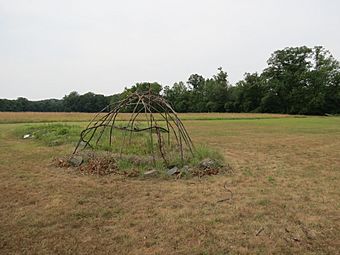Accokeek Creek Site facts for kids
|
Accokeek Creek Site
|
|
 |
|
| Nearest city | Accokeek, Maryland |
|---|---|
| NRHP reference No. | 66000909 |
Quick facts for kids Significant dates |
|
| Added to NRHP | October 15, 1966 |
| Designated NHL | July 19, 1964 |
The Accokeek Creek Site, also known as Moyaone, is an archaeological site in Prince George's County, Maryland. An archaeological site is a place where people lived long ago. This site is located along the Potomac River, right across from Mount Vernon. It is part of today's Piscataway Park.
People have lived at the Accokeek Creek Site on and off since about 2000 BC. Because of its important history, the Accokeek Creek Site was named a National Historic Landmark in 1964. This means it is a place of special historical importance in the United States.
Contents
What is the Accokeek Creek Site?
The National Park Service says this site is amazing. It has many places where people lived a long time ago. Accokeek included a village surrounded by a tall fence, called a palisade. This village was used from about 1300 AD to 1630 AD.
Archaeologists have used this site to learn about the history of cultures in the Mid-Atlantic region. Moyaone is like a "sister site" to another important place called Potomac Creek, 44ST2. Experts believe both sites were settled around the same time.
Life at the Ancient Village
The Accokeek Creek Site shows signs of life from as far back as 3,000 BC. Around 800 AD, during the Middle Woodland Period, small farming villages started to appear. The village known as Moyaone was active in the late 1500s and early 1600s. This village had many palisade fences and faced the Potomac River.
Archaeologists think about 300 to 320 people lived in Moyaone. The village covered an area of about 6,100 square meters. Digging at the site shows that people built new structures many times. This suggests they lived there for a very long time.
Near the village, archaeologists found four large burial pits called ossuaries. These ossuaries held the remains of over 1,000 people. The village was left empty before Europeans arrived in the area. Later, around 1674-1675, a rectangular fort was built at the north end of the area. This fort was used by the Susquehannock people.
Pottery from the Past
Pottery found at Moyaone is from the Late Woodland period, dating from about 1300 AD to 1650 AD. This type of pottery is found all along the western shore of Maryland. The pottery is special because it has fine sand and mica mixed into the clay. Mica is a shiny mineral, so it makes the pottery glitter a little.
The clay used was very fine, making the pottery soft and smooth. There are three main types of Moyaone pottery:
- Moyaone Plain: This pottery has no decorations.
- Moyaone Cord-Impressed: This pottery has simple designs made by pressing cords onto the clay. These designs are usually found on the rim or lip of the pot. They can be horizontal, vertical, or diagonal.
- Moyaone Incised: This pottery has designs made by scratching lines into the clay with a sharp or dull tool. These designs are also mostly on the lip, rim, and upper part of the pot.
Why is This Site Important?
The Accokeek Creek Site was first dug up by an archaeologist named Alice L.L. Ferguson in the 1930s and 1940s. Later, Robert L. Stephenson studied the items found there in the 1950s. This site helped experts understand how pottery styles changed over time in the Mid-Atlantic region. It helped create a timeline for different pottery types.
The Moyaone village was the largest and last village of the Piscataway people before Europeans came to the area.
The Story of Turkey Tayac
A leader of the Piscataway people, Turkey Tayac, wanted to help create Piscataway Park at this site. He had one special request: he wanted to be buried there. He also wanted his people to always be able to visit freely for their cultural and spiritual practices.
This agreement was made with a handshake, but it was not written down. So, Turkey Tayac was not buried at Moyaone right after he passed away in 1978. It took a year, until 1979, for the United States Congress to pass a law. This law allowed him to be buried in a national park area.



